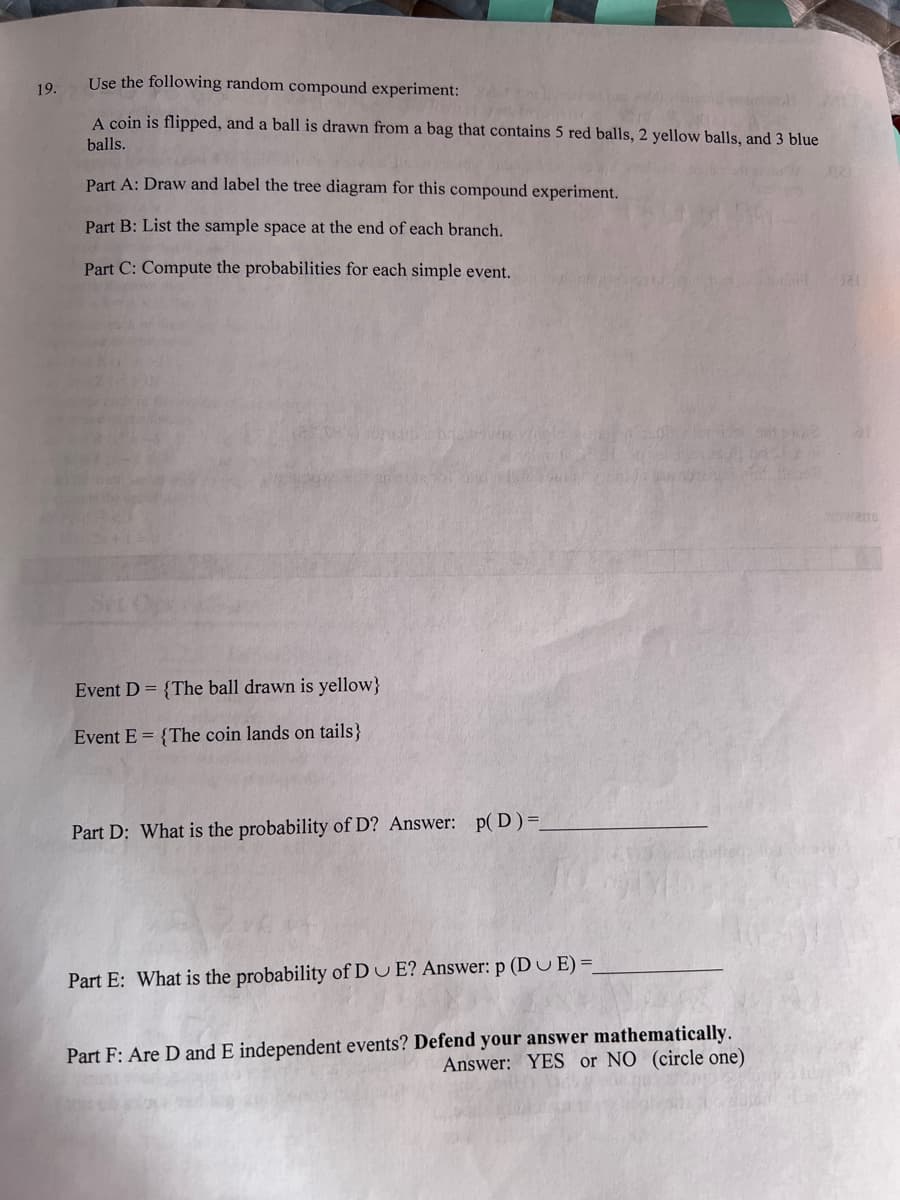19. Use the following random compound experiment: A coin is flipped, and a ball is drawn from a bag that contains 5 red balls, 2 yellow balls, and 3 blue balls. Part A: Draw and label the tree diagram for this compound experiment. Part B: List the sample space at the end of each branch. Part C: Compute the probabilities for each simple event. Event D = {The ball drawn is yellow} Event E= {The coin lands on tails} Part D: What is the probability of D? Answer: p(D)=_ Part E: What is the probability of DUE? Answer: p (DUE)=_ Quants? Defend your answer mathematically.
19. Use the following random compound experiment: A coin is flipped, and a ball is drawn from a bag that contains 5 red balls, 2 yellow balls, and 3 blue balls. Part A: Draw and label the tree diagram for this compound experiment. Part B: List the sample space at the end of each branch. Part C: Compute the probabilities for each simple event. Event D = {The ball drawn is yellow} Event E= {The coin lands on tails} Part D: What is the probability of D? Answer: p(D)=_ Part E: What is the probability of DUE? Answer: p (DUE)=_ Quants? Defend your answer mathematically.
A First Course in Probability (10th Edition)
10th Edition
ISBN:9780134753119
Author:Sheldon Ross
Publisher:Sheldon Ross
Chapter1: Combinatorial Analysis
Section: Chapter Questions
Problem 1.1P: a. How many different 7-place license plates are possible if the first 2 places are for letters and...
Related questions
Question

Transcribed Image Text:19.
Use the following random compound experiment:
A coin is flipped, and a ball is drawn from a bag that contains 5 red balls, 2 yellow balls, and 3 blue
balls.
Part A: Draw and label the tree diagram for this compound experiment.
Part B: List the sample space at the end of each branch.
Part C: Compute the probabilities for each simple event.
Event D = {The ball drawn is yellow}
Event E= {The coin lands on tails}
Part D: What is the probability of D? Answer: p(D)=_
Part E: What is the probability of DU E? Answer: p (DE) =_
Part F: Are D and E independent events? Defend your answer mathematically.
Answer: YES or NO (circle one)
321
Expert Solution
This question has been solved!
Explore an expertly crafted, step-by-step solution for a thorough understanding of key concepts.
Step by step
Solved in 2 steps with 2 images

Recommended textbooks for you

A First Course in Probability (10th Edition)
Probability
ISBN:
9780134753119
Author:
Sheldon Ross
Publisher:
PEARSON


A First Course in Probability (10th Edition)
Probability
ISBN:
9780134753119
Author:
Sheldon Ross
Publisher:
PEARSON
